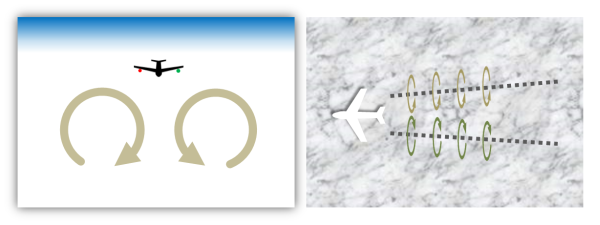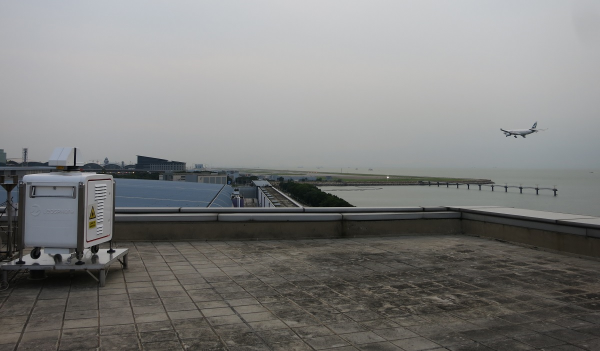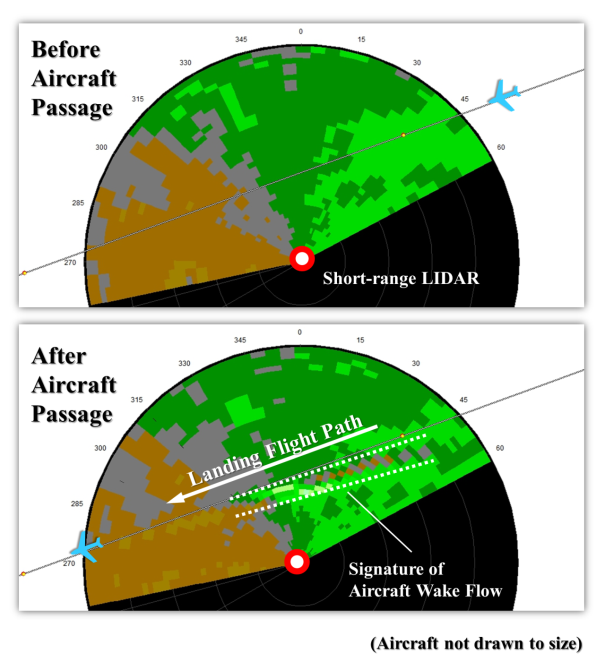The "Tail" of an Aircraft
The "Tail" of an Aircraft
HON Kai-kwong
July 2015
It has been mentioned in an earlier article (“In the wake of a duck”, June 2013) that, whenever a duck swims in the water (or any object propels itself using the reaction force from a fluid) it would naturally leave behind a series of wave patterns (Figure 1). The same also applies to an aircraft in flight.

Figure 1 Wake pattern left behind by a duck in water. (Photographed in Finland by the author)
When an aircraft is flying, the air pressure below its wings is higher than that above (thus providing lift). This pressure difference leads to the generation of vortices. The superposition of these vortices in turn generates a wake pattern, usually known as "aircraft wake turbulence" or "aircraft wake vortices" in the aviation community.

Figure 2 Schematic diagram of wake flow due to an aircraft. Vertical cross-section (as viewed from behind the aircraft) on the left, horizontal cross-section (as viewed from high above the aircraft) on the right.
Wake flow from an aircraft mainly comprises a pair of counter-rotating vortices (Figure 2). Since these vortices may contain severe turbulence and subsidence, a trailing aircraft along the same flight path must maintain a suitable distance (or "aircraft separation") from the preceding aircraft in order to prevent encountering its wake flow, which might affect flight safety. It is worth mentioning that aircraft wake flow is generally invisible to the naked eye under clear air conditions, in contrast to the phenomenon of "contrail" (the latter is mainly composed of ice crystals resulting from the condensation of water vapour within aircraft engine exhaust, hence more easily observable).

Figure 3 A short-range LIDAR (equipment in white to the left) performing scans near the arrival and departure corridors of the Hong Kong International Airport.
Vortices within aircraft wake flow are of relatively small size1, and often have a lifetime of only 1 to 2 minutes (or less) in the near-surface atmosphere. To observe these invisible airflow, remote-sensing instruments with high spatial and temporal resolution, such as the short-range LIDAR (light detection and ranging), would be required (Figure 3).

Figure 4 Signature of aircraft wake flow as revealed by short-range LIDAR scans conducted by the Observatory at the Hong Kong International Airport. Different colours correspond to different radial wind velocities. Wind fluctuations due to the presence of wake vortices are highlighted in white.
Within the display of wind velocities as measured by the short-range LIDAR, the counter-rotating vortex pair stands out from the background wind field with its unique signature. If you take a look at the planar wind speed distribution in Figure 4, doesn't it resemble two long "tails" left behind by the landing aircraft?
Footnote:
[1] The width of wake vortices is generally comparable to an aircraft's wingspan. For example, the vortices left behind by a Boeing 747-400 (with wingspan of about 65 metres) would have a diameter of about 30 to 40 metres on each side when close to the aircraft.
[1] The width of wake vortices is generally comparable to an aircraft's wingspan. For example, the vortices left behind by a Boeing 747-400 (with wingspan of about 65 metres) would have a diameter of about 30 to 40 metres on each side when close to the aircraft.





 Local Weather
Local Weather Weather Forecast
Weather Forecast Weather Warnings
Weather Warnings Weather for Fishermen
Weather for Fishermen Weather for Marine
Weather for Marine Weather for Aviation
Weather for Aviation Weather Monitoring Imagery
Weather Monitoring Imagery GIS Weather Service
GIS Weather Service Tropical Cyclone
Tropical Cyclone China Weather
China Weather World Weather
World Weather Climate Information Service
Climate Information Service Warnings & Signals Database
Warnings & Signals Database Statistics of Special Weather Events
Statistics of Special Weather Events Monthly Weather Summary
Monthly Weather Summary Climate Change
Climate Change El Nino and La Nina
El Nino and La Nina Earthquakes
Earthquakes Tsunamis
Tsunamis Tide
Tide Geomagnetism
Geomagnetism Space Weather
Space Weather Weather Information for Astronomical Observation
Weather Information for Astronomical Observation Interactive Sun Path Diagram
Interactive Sun Path Diagram Astronomical Data
Astronomical Data Interesting Astronomical Phenomena
Interesting Astronomical Phenomena Time Services
Time Services Calendar
Calendar Almanac
Almanac Real time Radiation level in Hong Kong
Real time Radiation level in Hong Kong Understanding Radiation
Understanding Radiation Radiation Monitoring, Assessment and Protection
Radiation Monitoring, Assessment and Protection Environmental Radiation Monitoring Programme
Environmental Radiation Monitoring Programme Daya Bay Contingency Plan
Daya Bay Contingency Plan Related Sites
Related Sites Schools
Schools Travel
Travel Sports
Sports Outdoor Photography
Outdoor Photography CWOS
CWOS Senior Citizens
Senior Citizens Stargazers
Stargazers FoOb
FoOb My Little Observatory
My Little Observatory Educational Resources
Educational Resources 360 Tour of HKO
360 Tour of HKO Cloud Appreciation by Dr Tin
Cloud Appreciation by Dr Tin International Cloud Atlas
International Cloud Atlas Guided Tour
Guided Tour Courses and Activities for the Public
Courses and Activities for the Public Subscription of e-Bulletins
Subscription of e-Bulletins Research Forum
Research Forum Publications
Publications International Atomic Energy Agency
International Atomic Energy Agency Regional Specialized Meteorological Centre for nowcasting
Regional Specialized Meteorological Centre for nowcasting Asian Aviation Meteorological Center
Asian Aviation Meteorological Center Social Media
Social Media Press Releases
Press Releases What's New
What's New HKO Updates
HKO Updates LegCo Questions and Answers
LegCo Questions and Answers Observatory's Blog
Observatory's Blog Weather On-Air
Weather On-Air Cool Met Stuff
Cool Met Stuff Central Briefing
Central Briefing Tropical Cyclone Report Broadcast
Tropical Cyclone Report Broadcast Observatory's News
Observatory's News Vacancies
Vacancies Tender Notices
Tender Notices Apps
Apps Personalized Website
Personalized Website Weather Wizard
Weather Wizard Weather Information in Text
Weather Information in Text Weather Information in RSS
Weather Information in RSS Audio Web Page
Audio Web Page Forms
Forms Open Data
Open Data HKO Corporate Video
HKO Corporate Video Vision and Mission
Vision and Mission Organizational Structure
Organizational Structure Quality Management
Quality Management Hong Kong Observatory – The Facts
Hong Kong Observatory – The Facts Hong Kong Observatory 2024
Hong Kong Observatory 2024 Our Services
Our Services Programme Areas of the Observatory
Programme Areas of the Observatory History of the Hong Kong Observatory
History of the Hong Kong Observatory Career@HKO
Career@HKO Visitors Figures
Visitors Figures











